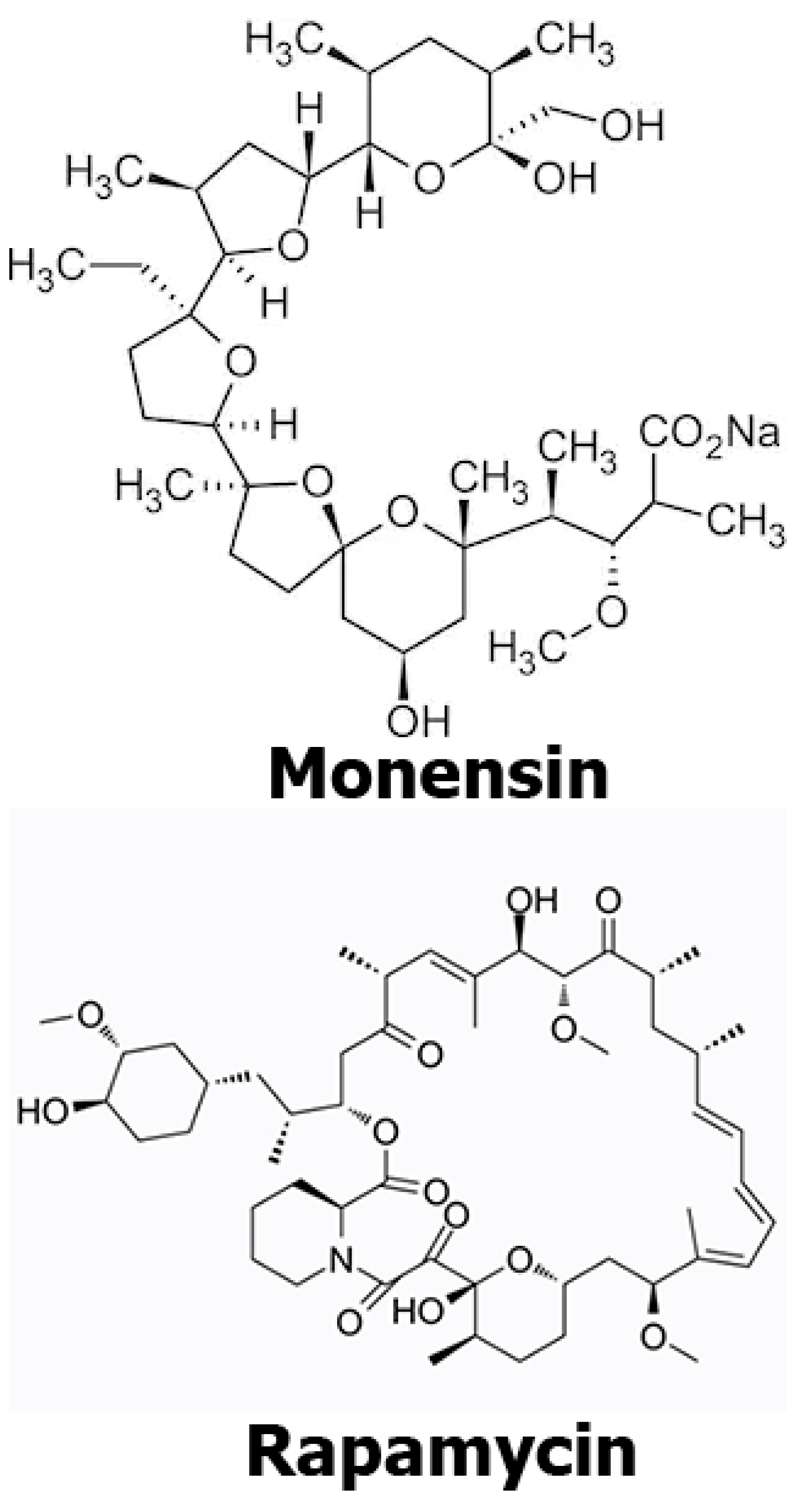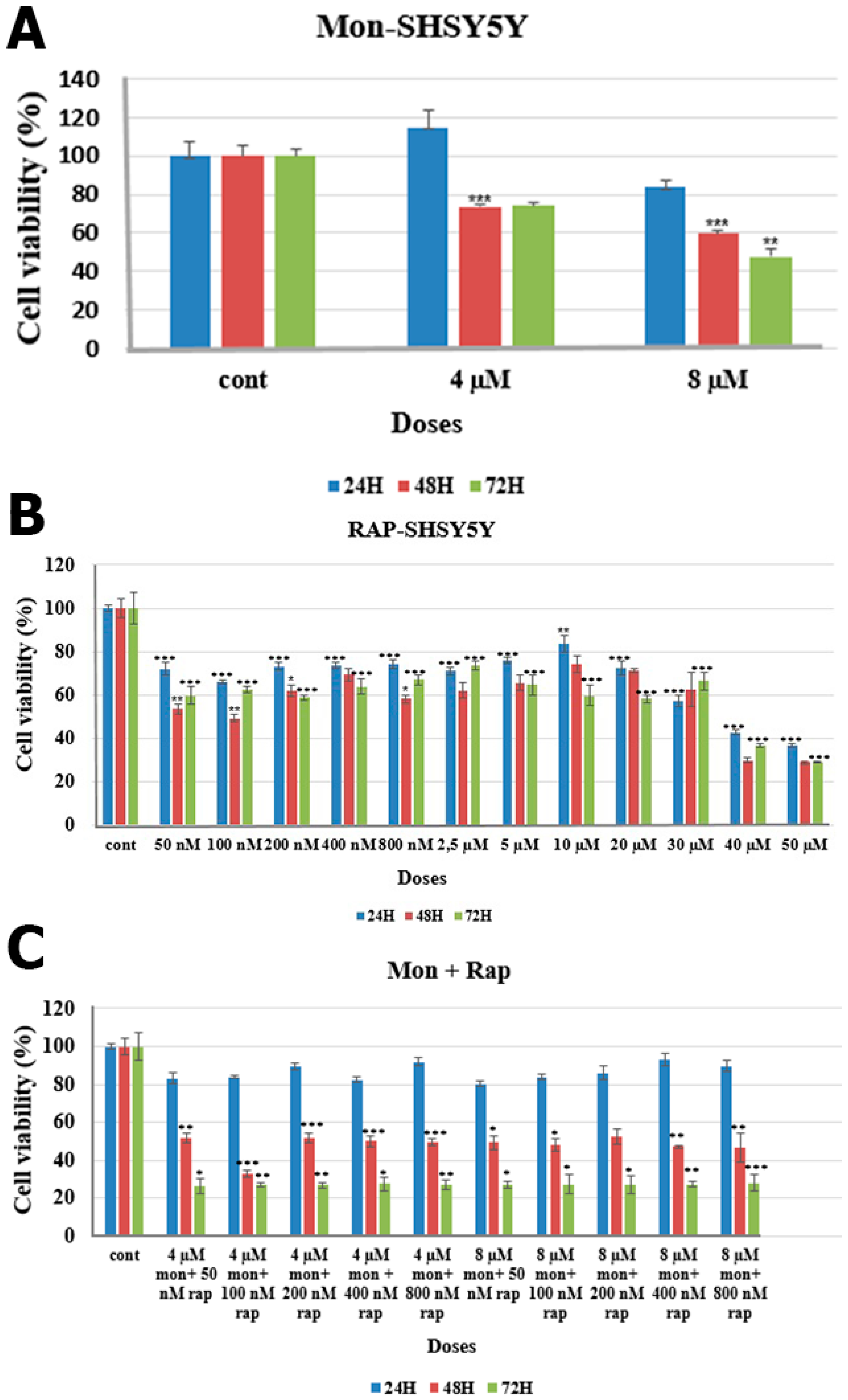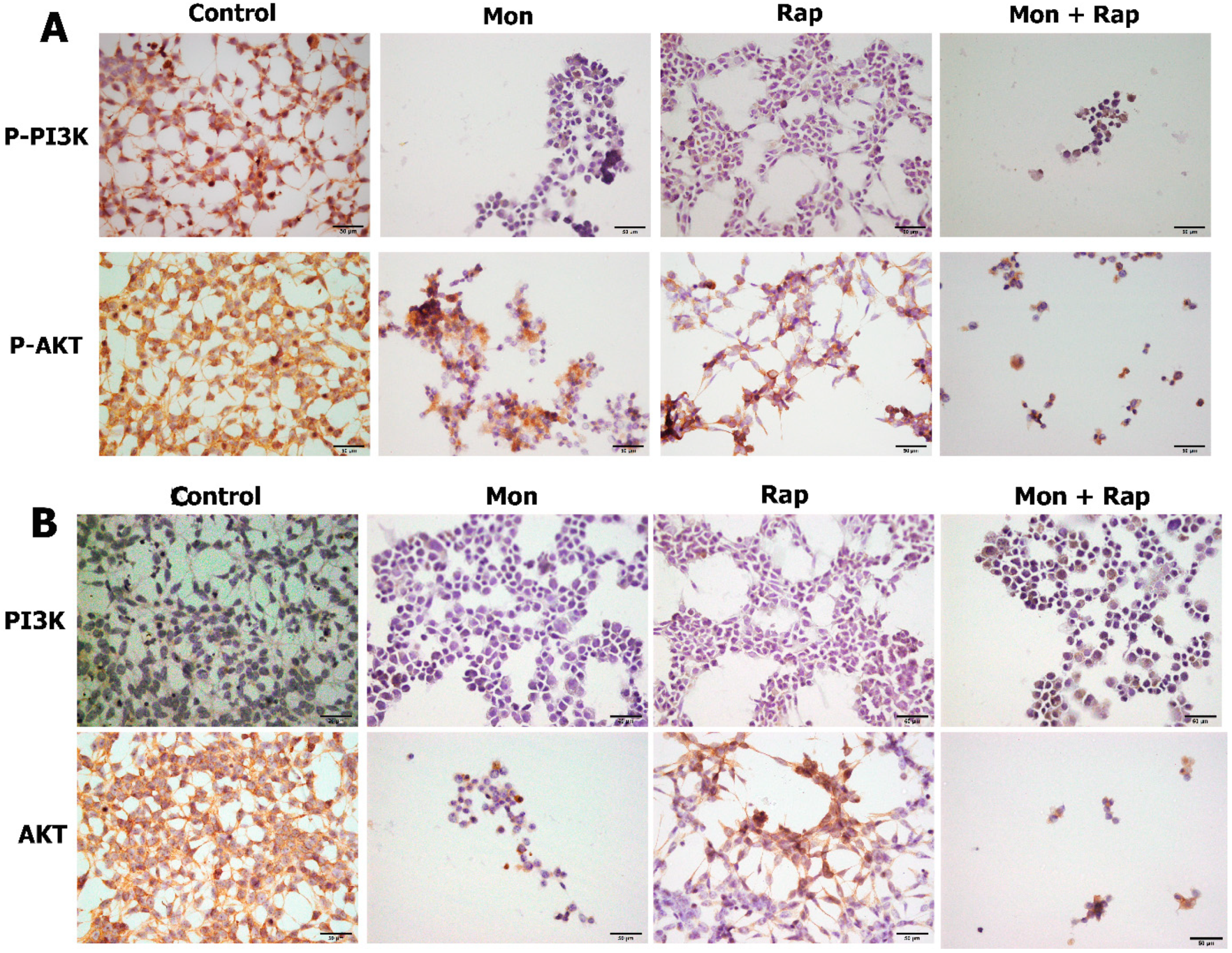Monensin, an Antibiotic Isolated from Streptomyces Cinnamonensis, Regulates Human Neuroblastoma Cell Proliferation via the PI3K/AKT Signaling Pathway and Acts Synergistically with Rapamycin
Abstract
:1. Introduction
2. Results
2.1. The Effect of Single and Combined Administration of Mon and Rap on SH-SY5Y Cell Viability
2.2. Determination of the Effect of Single and Combined Doses of Mon and Rap on PI3K/AKT Protein Expression Using Immunohistochemistry
2.3. Determination of the Effect of Single and Combined Doses of Mon and Rap on PI3K/AKT Protein Expression Using Immunofluorescence Method
2.4. Determination of the Effect of Single and Combined Doses of Mon and Rap on PI3K/AKT Protein Expression Using SDS-Polyacrylamide Gel Electrophoresis (SDS-PAGE) and Western Blotting
2.5. Determination of the Effects of Single and Combined Doses of Mon and Rap on the Expression of Genes Associated with the PI3K/AKT Pathway Using RT-PCR Method
3. Discussion
4. Materials and Methods
4.1. Cell Culture
4.2. Cell Viability Assay
4.3. Immunohistochemistry
4.4. Immunofluorescence Staining
4.5. Western Blot
4.6. RT-PCR
4.7. Statistical Analysis
5. Conclusions
Author Contributions
Funding
Institutional Review Board Statement
Informed Consent Statement
Data Availability Statement
Conflicts of Interest
Human and Animal Rights
References
- Chung, C.; Boterberg, T.; Lucas, J.; Panoff, J.; Valteau-Couanet, D.; Hero, B.; Bagatell, R.; Hill-Kayser, C.E. Neuroblastoma. Pediatr. Blood Cancer 2021, 68, e28473. [Google Scholar] [CrossRef]
- Lundberg, K.I.; Treis, D.; Johnsen, J.I. Neuroblastoma Heterogeneity, Plasticity, and Emerging Therapies. Curr. Oncol. Rep. 2022, 24, 1053–1062. [Google Scholar] [CrossRef] [PubMed]
- Maris, J.M. Recent Advances in Neuroblastoma. N. Engl. J. Med. 2010, 362, 2202–2211. [Google Scholar] [CrossRef] [PubMed] [Green Version]
- Alexander, F. Neuroblastoma. Urol. Clin. North Am. 2000, 27, 383–392. [Google Scholar] [CrossRef]
- Ishola, T.A.; Chung, D.H. Neuroblastoma. Surg. Oncol. 2007, 16, 149–156. [Google Scholar] [CrossRef]
- Rajendran, V.; Ilamathi, H.S.; Dutt, S.; Lakshminarayana, T.S.; Ghosh, P.C. Chemotherapeutic Potential of Monensin as an Anti-Microbial Agent. Curr. Top. Med. Chem. 2018, 18, 1976–1986. [Google Scholar] [CrossRef] [PubMed]
- Zeng, C.; Long, M.; Lu, Y. Monensin Synergizes with Chemotherapy in Uveal Melanoma through Suppressing RhoA. Immunopharmacol. Immunotoxicol. 2022, 45, 35–42. [Google Scholar] [CrossRef]
- Yao, S.; Wang, W.; Zhou, B.; Cui, X.; Yang, H.; Zhang, S. Monensin Suppresses Cell Proliferation and Invasion in Ovarian Cancer by Enhancing MEK1 SUMOylation. Exp. Ther. Med. 2021, 22, 1–10. [Google Scholar] [CrossRef] [PubMed]
- Kim, S.-H.; Kim, K.-Y.; Yu, S.-N.; Park, S.-G.; Yu, H.-S.; Seo, Y.-K.; Ahn, S.-C. Monensin Induces PC-3 Prostate Cancer Cell Apoptosis via ROS Production and Ca2+ Homeostasis Disruption. Anticancer. Res. 2016, 36, 5835–5844. [Google Scholar] [CrossRef] [Green Version]
- Choi, H.S.; Jeong, E.H.; Lee, T.G.; Kim, S.Y.; Kim, H.R.; Kim, C.H. Autophagy Inhibition with Monensin Enhances Cell Cycle Arrest and Apoptosis Induced by MTOR or Epidermal Growth Factor Receptor Inhibitors in Lung Cancer Cells. Tuberc. Respir. Dis. 2013, 75, 9–17. [Google Scholar] [CrossRef] [PubMed] [Green Version]
- Wang, X.; Wu, X.; Zhang, Z.; Ma, C.; Wu, T.; Tang, S.; Zeng, Z.; Huang, S.; Gong, C.; Yuan, C.; et al. Monensin Inhibits Cell Proliferation and Tumor Growth of Chemo-Resistant Pancreatic Cancer Cells by Targeting the EGFR Signaling Pathway. Sci-Entific Rep. 2018, 8, 1–15. [Google Scholar] [CrossRef] [Green Version]
- Gu, J.; Huang, L.; Zhang, Y. Monensin Inhibits Proliferation, Migration, and Promotes Apoptosis of Breast Cancer Cells via Downregulating UBA2. Drug Dev. Res. 2020, 81, 745–753. [Google Scholar] [CrossRef] [PubMed]
- Deng, Y.; Zhang, J.; Wang, Z.; Yan, Z.; Qiao, M.; Ye, J.; Wei, Q.; Wang, J.; Wang, X.; Zhao, L.; et al. Antibiotic Monensin Synergizes with EGFR Inhibitors and Oxaliplatin to Suppress the Proliferation of Human Ovarian Cancer Cells. Sci. Rep. 2015, 5, 17523. [Google Scholar] [CrossRef] [PubMed] [Green Version]
- Markowska, A.; Kaysiewicz, J.; Markowska, J.; Huczyński, A. Doxycycline, Salinomycin, Monensin and Ivermectin Repositioned as Cancer Drugs. Bioorganic Med. Chem. Lett. 2019, 29, 1549–1554. [Google Scholar] [CrossRef]
- Zhang, X.; Liu, C.; Cao, Y.; Liu, L.; Sun, F.; Hou, L. RRS1 Knockdown Inhibits the Proliferation of Neuroblastoma Cell via PI3K/Akt/NF-ΚB Pathway. Pediatr. Res. 2022. [CrossRef]
- Sartelet, H.; Oligny, L.L.; Vassal, G. AKT Pathway in Neuroblastoma and Its Therapeutic Implication. Expert Rev. Anti-Cancer Ther. 2008, 8, 757–769. [Google Scholar] [CrossRef]
- Opel, D.; Poremba, C.; Simon, T.; Debatin, K.M.; Fulda, S. Activation of Akt Predicts Poor Outcome in Neuroblastoma. Cancer Res. 2007, 67, 735–745. [Google Scholar] [CrossRef] [Green Version]
- Li, J.; Kim, S.G.; Blenis, J. Rapamycin: One Drug, Many Effects. Cell Metab. 2014, 19, 373. [Google Scholar] [CrossRef] [Green Version]
- Blagosklonny, M.V. From Rapalogs to Anti-Aging Formula. Oncotarget 2017, 8, 35492. [Google Scholar] [CrossRef] [PubMed] [Green Version]
- Waldner, M.; Fantus, D.; Solari, M.; Thomson, A.W. New Perspectives on MTOR Inhibitors (Rapamycin, Rapalogs and TORKinibs) in Transplantation. Br. J. Clin. Pharmacol. 2016, 82, 1158–1170. [Google Scholar] [CrossRef] [PubMed] [Green Version]
- Chen, X.G.; Liu, F.; Song, X.F.; Wang, Z.H.; Dong, Z.Q.; Hu, Z.Q.; Lan, R.Z.; Guan, W.; Zhou, T.G.; Xu, X.M.; et al. Rapamy-cin Regulates Akt and ERK Phosphorylation through MTORC1 and MTORC2 Signaling Pathways. Mol. Carcinog. 2010, 49, 603–610. [Google Scholar] [CrossRef]
- King, D.; Yeomanson, D.; Bryant, H.E. PI3King the Lock: Targeting the PI3K/Akt/MTOR Pathway as a Novel Therapeutic Strategy in Neuroblastoma. J. Pediatr. Hematol./Oncol. 2015, 37, 245–251. [Google Scholar] [CrossRef] [PubMed]
- Verma, S.P.; Das, P. Monensin Induces Cell Death by Autophagy and Inhibits Matrix Metalloproteinase 7 (MMP7) in UOK146 Renal Cell Carcinoma Cell Line. Vitr. Cell. Dev. Biol. Anim. 2018, 54, 736–742. [Google Scholar] [CrossRef] [PubMed]
- Knight, Z.A.; Shokat, K.M. Chemically Targeting the PI3K Family. Biochem. Soc. Trans. 2007, 35, 245–249. [Google Scholar] [CrossRef] [Green Version]
- Liu, P.; Cheng, H.; Roberts, T.M.; Zhao, J.J. Targeting the Phosphoinositide 3-Kinase Pathway in Cancer. Nat. Rev. Drug Discov. 2009, 8, 627–644. [Google Scholar] [CrossRef] [Green Version]
- Wong, K.-K.; Engelman, J.A.; Cantley, L.C. Targeting the PI3K Signaling Pathway in Cancer. Curr. Opin. Genet. Dev. 2010, 20, 87–90. [Google Scholar] [CrossRef] [Green Version]
- Lin, X.; Han, L.; Weng, J.; Wang, K.; Chen, T. Rapamycin Inhibits Proliferation and Induces Autophagy in Human Neuro-blastoma Cells. Biosci. Rep. 2018, 38, BSR20181822. [Google Scholar] [CrossRef] [PubMed] [Green Version]
- Johnsen, J.I.; Segerström, L.; Orrego, A.; Elfman, L.; Henriksson, M.; Kågedal, B.; Eksborg, S.; Sveinbjörnsson, B.; Kogner, P. Inhibitors of Mammalian Target of Rapamycin Downregulate MYCN Protein Expression and Inhibit Neuroblastoma Growth in Vitro and in Vivo. Oncogene 2008, 27, 2910–2922. [Google Scholar] [CrossRef] [Green Version]
- Moreno-Smith, M.; Lakoma, A.; Chen, Z.; Tao, L.; Scorsone, K.A.; Schild, L.; Aviles-Padilla, K.; Nikzad, R.; Zhang, Y.; Chakraborty, R.; et al. P53 Nongenotoxic Activation and MTORC1 Inhibition Lead to Effective Combination for Neuroblas-toma Therapy. Clin. Cancer Res. Off. J. Am. Assoc. Cancer Res. 2017, 23, 6629–6639. [Google Scholar] [CrossRef] [PubMed] [Green Version]
- Zhang, L.; Smith, K.M.; Chong, A.L.; Stempak, D.; Yeger, H.; Marrano, P.; Thorner, P.S.; Irwin, M.S.; Kaplan, D.R.; Baruchel, S. In Vivo Antitumor and Antimetastatic Activity of Sunitinib in Preclinical Neuroblastoma Mouse Model. Neoplasia 2009, 11, 426–435. [Google Scholar] [CrossRef] [Green Version]
- Liao, J.; Jiang, L.; Wang, C.; Zhao, D.; He, W.; Zhou, K.; Liang, Y. FoxM1 Regulates Proliferation and Apoptosis of Human Neuroblastoma Cell through PI3K/AKT Pathway. Fetal Pediatr. Pathol. 2022, 41, 355–370. [Google Scholar] [CrossRef] [PubMed]
- Fresno Vara, J.Á.; Casado, E.; de Castro, J.; Cejas, P.; Belda-Iniesta, C.; González-Barón, M. PI3K/Akt Signalling Pathway and Cancer. Cancer Treat. Rev. 2004, 30, 193–204. [Google Scholar] [CrossRef]
- Noorolyai, S.; Shajari, N.; Baghbani, E.; Sadreddini, S.; Baradaran, B. The Relation between PI3K/AKT Signalling Pathway and Cancer. Gene 2019, 698, 120–128. [Google Scholar] [CrossRef]
- Fulda, S. The PI3K/Akt/MTOR Pathway as Therapeutic Target in Neuroblastoma. Curr. Cancer Drug Targets 2009, 9, 729–737. [Google Scholar] [CrossRef] [PubMed]
- Kocoglu, S.S.; Seçme, M.; Elmas, L. Erianin, a Promising Agent in the Treatment of Glioblastoma Multiforme Triggers Apoptosis in U373 and A172 Glioblastoma Cells. Arch. Biol. Sci. 2022, 74, 227–234. [Google Scholar] [CrossRef]
- Tezcan, B.; Serter, S.; Kiter, E.; Tufan, A.C. Dose Dependent Effect of C-Type Natriuretic Peptide Signaling in Glycosaminoglycan Synthesis during TGF-Β1 Induced Chondrogenic Differentiation of Mesenchymal Stem Cells. J. Mol. Histol. 2010, 41, 247–258. [Google Scholar] [CrossRef]






| 48 h | 72 h | |||
|---|---|---|---|---|
| Mon | 4 µM | 8 µM | 4 µM | 8 µM |
| 50 nM rap | 0.82 | 1.14 | 0.28 | 0.57 |
| 100 nM rap | 0.19 | 1.45 | 0.29 | 0.59 |
| 200 nM rap | 3.17 | 4.09 | 0.28 | 0.59 |
| 400 nM rap | 5.09 | 3.41 | 0.29 | 0.59 |
| 800 nM rap | 8.32 | 5.31 | 0.28 | 0.59 |
| Mon | Rap | Mon + Rap | ||||
|---|---|---|---|---|---|---|
| Gene | Fold Regulation | p-Value | Fold Regulation | p-Value | Fold Regulation | p-Value |
| AKT | 1.08 | 0.555 | −1.25 | 0.109 | −1.61 | 0.007 |
| MAPK1 | −1.34 | 0.178 | −1.19 | 0.977 | −1.55 | 0.049 |
| P21RAS | −1.31 | 0.025 | −2.77 | 0.0007 | −1.53 | 0.01 |
| PIK3C3 | −1.09 | 0.656 | 2.86 | 0.388 | −8.43 | 0.258 |
| PTEN | −1.52 | 0.585 | −7.40 | 0.211 | −20.07 | 0.203 |
| Beta-Actin | 1 | 1 | 1 | |||
Disclaimer/Publisher’s Note: The statements, opinions and data contained in all publications are solely those of the individual author(s) and contributor(s) and not of MDPI and/or the editor(s). MDPI and/or the editor(s) disclaim responsibility for any injury to people or property resulting from any ideas, methods, instructions or products referred to in the content. |
© 2023 by the authors. Licensee MDPI, Basel, Switzerland. This article is an open access article distributed under the terms and conditions of the Creative Commons Attribution (CC BY) license (https://creativecommons.org/licenses/by/4.0/).
Share and Cite
Serter Kocoglu, S.; Secme, M.; Oy, C.; Korkusuz, G.; Elmas, L. Monensin, an Antibiotic Isolated from Streptomyces Cinnamonensis, Regulates Human Neuroblastoma Cell Proliferation via the PI3K/AKT Signaling Pathway and Acts Synergistically with Rapamycin. Antibiotics 2023, 12, 546. https://doi.org/10.3390/antibiotics12030546
Serter Kocoglu S, Secme M, Oy C, Korkusuz G, Elmas L. Monensin, an Antibiotic Isolated from Streptomyces Cinnamonensis, Regulates Human Neuroblastoma Cell Proliferation via the PI3K/AKT Signaling Pathway and Acts Synergistically with Rapamycin. Antibiotics. 2023; 12(3):546. https://doi.org/10.3390/antibiotics12030546
Chicago/Turabian StyleSerter Kocoglu, Sema, Mücahit Secme, Ceren Oy, Gözde Korkusuz, and Levent Elmas. 2023. "Monensin, an Antibiotic Isolated from Streptomyces Cinnamonensis, Regulates Human Neuroblastoma Cell Proliferation via the PI3K/AKT Signaling Pathway and Acts Synergistically with Rapamycin" Antibiotics 12, no. 3: 546. https://doi.org/10.3390/antibiotics12030546





